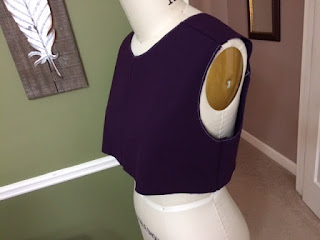A new pattern is almost always a salivating experience for me. It must be that way for some people who enjoy jigsaw puzzles. It's never quite as much fun the second time around though.
The new Memphis dress from the Sewing Workshop was intriguing and a fun make. This one is a sort of wearable muslin. Since knit is required, muslin cannot be used, of course. So I used remnants of ponte in my stash.
I started with this purple remnant. I had just enough to test the bodice of the Medium. I could see that I'd need to take it in at the shoulders just a smidge. The pattern does not really fit anywhere else so I proceeded with the wearable version.
As with so many of these assymetrical patterns, almost every piece required cutting in a single layer. The exceptions were the sleeves and the back yoke. As you can see, I did not have enough of my remnants to cut out full length sleeves. That's OK anyway because warm weather is headed my way.
 |
| The pattern is designed with a forward shoulder. |
I tested it as a tunic before attaching the lower bands. Not too bad.
My two fabrics are both ponte knit but the black one is slightly heavier and more stable. I think this will cause the dress to grow. That may be a problem. I can always remove the lower bands and go with the tunic idea.
I have enough of a poly knit that may be worth trying next. But then I don't wear dresses. Much. Each time I make a dress, I think, maybe this time. I am the eternal optimist when it comes to sewing. Are you too?


















































